【视频】经济学:金融市场 07 行为金融学 (Behavioral Finance)
- 格式:doc
- 大小:70.00 KB
- 文档页数:14
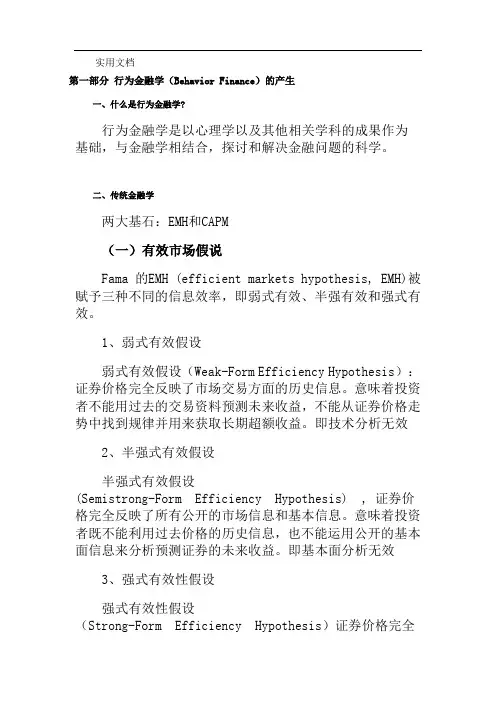
第一部分行为金融学(Behavior Finance)的产生一、什么是行为金融学?行为金融学是以心理学以及其他相关学科的成果作为基础,与金融学相结合,探讨和解决金融问题的科学。
二、传统金融学两大基石:EMH和CAPM(一)有效市场假说Fama 的EMH (efficient markets hypothesis, EMH)被赋予三种不同的信息效率,即弱式有效、半强有效和强式有效。
1、弱式有效假设弱式有效假设(Weak-Form Efficiency Hypothesis):证券价格完全反映了市场交易方面的历史信息。
意味着投资者不能用过去的交易资料预测未来收益,不能从证券价格走势中找到规律并用来获取长期超额收益。
即技术分析无效2、半强式有效假设半强式有效假设(Semistrong-Form Efficiency Hypothesis) , 证券价格完全反映了所有公开的市场信息和基本信息。
意味着投资者既不能利用过去价格的历史信息,也不能运用公开的基本面信息来分析预测证券的未来收益。
即基本面分析无效3、强式有效性假设强式有效性假设(Strong-Form Efficiency Hypothesis)证券价格完全反映所有公开的和内部的信息。
意味着任何信息对投资分析者毫无用处,专业投资者的市场价值为零,专业投资者所要做的唯一事情就是构建与其偏好相应的资产组合,然后买入持有。
(二)EMH的涵义有效市场假说认为股价会反映所有的相关信息,即使股价偏离基本价值,也是因为信息的不对称或者对信息的理解差异所导致。
只要价格偏离基本价值,理性交易者将立即抓住机会,从而纠正错误定价。
积极的投资者无论采用基本面分析还是技术分析都无法“打败”(或战胜)市场,即不可能获取“超额收益”(Abnormal Returns)(三)CAPM模型1、CAPM假设(1)证券市场是有效的,以EMH为基础(2)无风险证券存在,投资者可以自由地按无风险利率借入或贷出资本(3)投资总风险可以用方差或标准差表示,系统风险可用β系数表示(4)所有的投资者都是理性的,可以理性作出投资决策(5)没有交易成本(6)证券市场是无摩擦的(7)每项资产都是无限可分的2、CAPM模型表达式CAPM模型:E(Rp)=Rf+β(Rm-Rf)E(Rp)表示投资组合的期望收益率,Rf为无风险报酬率,β为某一组合的系统风险系数。
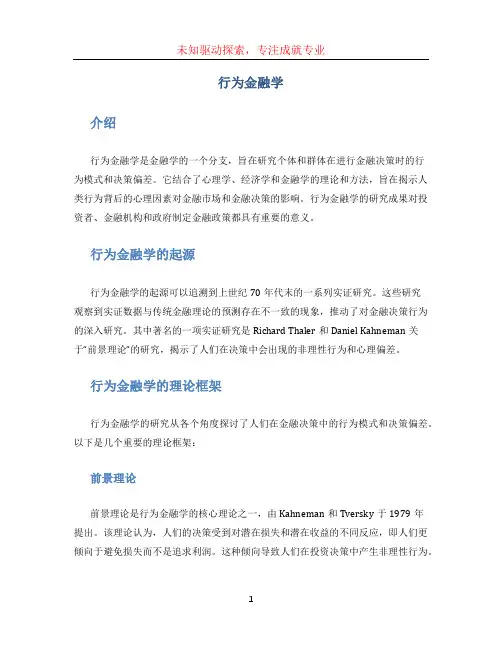
行为金融学介绍行为金融学是金融学的一个分支,旨在研究个体和群体在进行金融决策时的行为模式和决策偏差。
它结合了心理学、经济学和金融学的理论和方法,旨在揭示人类行为背后的心理因素对金融市场和金融决策的影响。
行为金融学的研究成果对投资者、金融机构和政府制定金融政策都具有重要的意义。
行为金融学的起源行为金融学的起源可以追溯到上世纪70年代末的一系列实证研究。
这些研究观察到实证数据与传统金融理论的预测存在不一致的现象,推动了对金融决策行为的深入研究。
其中著名的一项实证研究是Richard Thaler和Daniel Kahneman关于“前景理论”的研究,揭示了人们在决策中会出现的非理性行为和心理偏差。
行为金融学的理论框架行为金融学的研究从各个角度探讨了人们在金融决策中的行为模式和决策偏差。
以下是几个重要的理论框架:前景理论前景理论是行为金融学的核心理论之一,由Kahneman和Tversky于1979年提出。
该理论认为,人们的决策受到对潜在损失和潜在收益的不同反应,即人们更倾向于避免损失而不是追求利润。
这种倾向导致人们在投资决策中产生非理性行为。
群体行为群体行为指的是人们在群体中的行为模式对金融市场的影响。
在金融市场中,情绪的传导和信息的共享在一定程度上会影响投资者的决策。
例如,当市场情绪高涨时,投资者更容易盲目跟风,导致市场泡沫的形成。
决策偏差决策偏差是指人们在金融决策中常常偏离理性决策的现象。
这些偏差包括过度自信、损失厌恶、套利限制等。
这些偏差导致人们做出非理性的投资决策,进而影响市场的正常运行。
行为金融学的应用行为金融学的研究成果对投资者、金融机构和政府制定金融政策都具有较大的意义。
以下是一些行为金融学在实际应用中的例子:投资者教育行为金融学的研究成果可以帮助投资者了解自己在金融决策中的偏差和弱点。
通过提供相关的教育和培训,投资者可以更好地认识自己的决策风格,避免一些常见的投资错误。
金融产品设计行为金融学的研究成果可以帮助金融机构设计更符合投资者需求的金融产品。
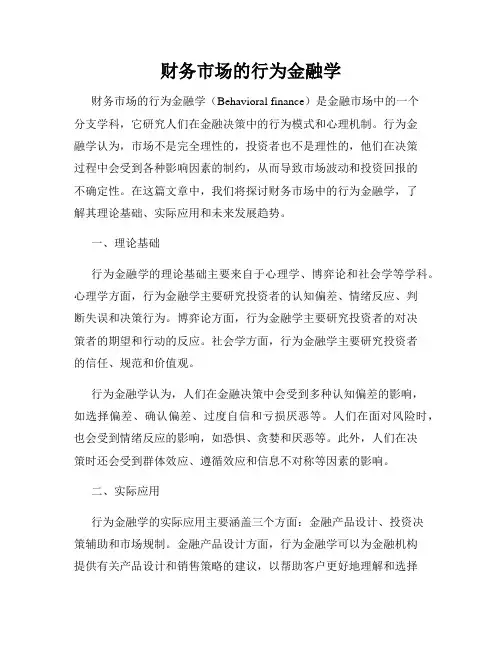
财务市场的行为金融学财务市场的行为金融学(Behavioral finance)是金融市场中的一个分支学科,它研究人们在金融决策中的行为模式和心理机制。
行为金融学认为,市场不是完全理性的,投资者也不是理性的,他们在决策过程中会受到各种影响因素的制约,从而导致市场波动和投资回报的不确定性。
在这篇文章中,我们将探讨财务市场中的行为金融学,了解其理论基础、实际应用和未来发展趋势。
一、理论基础行为金融学的理论基础主要来自于心理学、博弈论和社会学等学科。
心理学方面,行为金融学主要研究投资者的认知偏差、情绪反应、判断失误和决策行为。
博弈论方面,行为金融学主要研究投资者的对决策者的期望和行动的反应。
社会学方面,行为金融学主要研究投资者的信任、规范和价值观。
行为金融学认为,人们在金融决策中会受到多种认知偏差的影响,如选择偏差、确认偏差、过度自信和亏损厌恶等。
人们在面对风险时,也会受到情绪反应的影响,如恐惧、贪婪和厌恶等。
此外,人们在决策时还会受到群体效应、遵循效应和信息不对称等因素的影响。
二、实际应用行为金融学的实际应用主要涵盖三个方面:金融产品设计、投资决策辅助和市场规制。
金融产品设计方面,行为金融学可以为金融机构提供有关产品设计和销售策略的建议,以帮助客户更好地理解和选择金融产品。
投资决策辅助方面,行为金融学可以为投资者提供行为金融咨询和风险管理建议,以帮助他们做出更明智的投资决策。
市场规制方面,行为金融学可以为金融监管机构提供政策建议,以更好地保护投资者的权益和维护市场秩序。
以资产定价为例,行为金融学认为,投资者的做法是非理性的,由于投资者在信息充分而基础论不成立的情况下,进行了高度风险规避的操作,引发了一定的市场波动。
因此,在资产定价方面,行为金融学反对Efficient Market Hypothesis(有效市场假说),认为市场并不是完全理性的,也不是完全有效的,它存在着诸如信息异质性以及交易者非理性行为等因素。

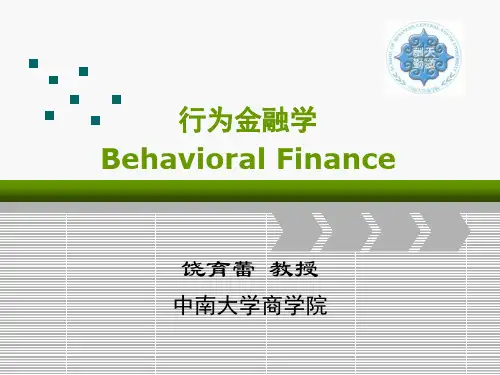
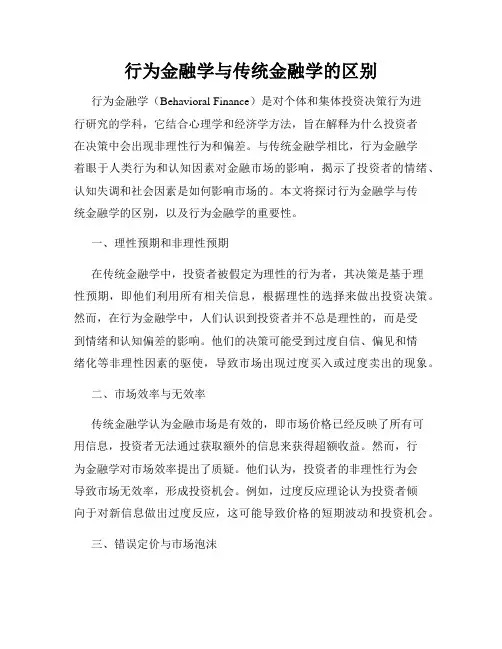
行为金融学与传统金融学的区别行为金融学(Behavioral Finance)是对个体和集体投资决策行为进行研究的学科,它结合心理学和经济学方法,旨在解释为什么投资者在决策中会出现非理性行为和偏差。
与传统金融学相比,行为金融学着眼于人类行为和认知因素对金融市场的影响,揭示了投资者的情绪、认知失调和社会因素是如何影响市场的。
本文将探讨行为金融学与传统金融学的区别,以及行为金融学的重要性。
一、理性预期和非理性预期在传统金融学中,投资者被假定为理性的行为者,其决策是基于理性预期,即他们利用所有相关信息,根据理性的选择来做出投资决策。
然而,在行为金融学中,人们认识到投资者并不总是理性的,而是受到情绪和认知偏差的影响。
他们的决策可能受到过度自信、偏见和情绪化等非理性因素的驱使,导致市场出现过度买入或过度卖出的现象。
二、市场效率与无效率传统金融学认为金融市场是有效的,即市场价格已经反映了所有可用信息,投资者无法通过获取额外的信息来获得超额收益。
然而,行为金融学对市场效率提出了质疑。
他们认为,投资者的非理性行为会导致市场无效率,形成投资机会。
例如,过度反应理论认为投资者倾向于对新信息做出过度反应,这可能导致价格的短期波动和投资机会。
三、错误定价与市场泡沫行为金融学强调价格的过度或低估可能是由于投资者的非理性行为和认知误差所致。
错误定价是指市场价格与基本价值之间的差异,这种差异可能导致投资机会。
市场泡沫则是指资产价格出现持续上升或下降,并与基本价值偏离较大的情况。
传统金融学很少关注这些非理性的影响因素,而行为金融学认为它们对市场走势和资产定价具有重要影响。
四、套利和限制传统金融学中,套利是投资者通过买入低价资产并卖出高价资产来获得风险调整后的回报。
而行为金融学认为,由于投资者的非理性行为和市场情绪,套利机会并非总是可行的。
投资者可能会根据自己的情感做出决策,导致市场出现非理性定价,从而限制了套利的效果。
此外,行为金融学也认识到了投资者的心理账户效应,即投资者会根据不同的账户将资产归类,对不同账户的资产有不同的风险容忍度,这也限制了套利的可能性。
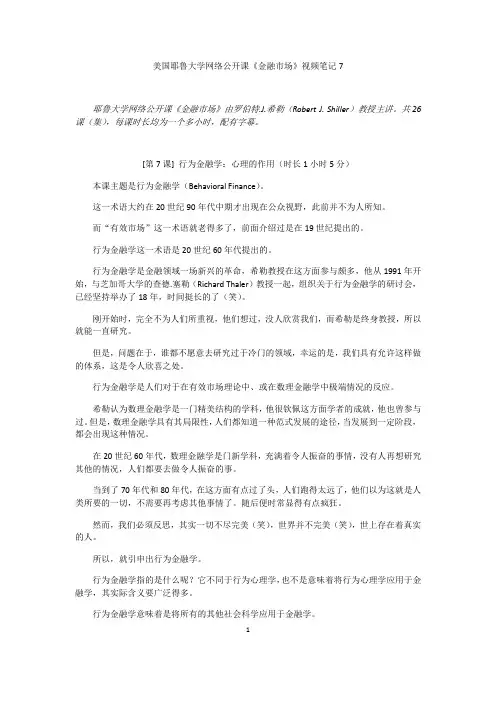
美国耶鲁大学网络公开课《金融市场》视频笔记7耶鲁大学网络公开课《金融市场》由罗伯特.J.希勒(Robert J. Shiller)教授主讲。
共26课(集),每课时长均为一个多小时,配有字幕。
[第7课] 行为金融学:心理的作用(时长1小时5分)本课主题是行为金融学(Behavioral Finance)。
这一术语大约在20世纪90年代中期才出现在公众视野,此前并不为人所知。
而“有效市场”这一术语就老得多了,前面介绍过是在19世纪提出的。
行为金融学这一术语是20世纪60年代提出的。
行为金融学是金融领域一场新兴的革命,希勒教授在这方面参与颇多,他从1991年开始,与芝加哥大学的查德.塞勒(Richard Thaler)教授一起,组织关于行为金融学的研讨会,已经坚持举办了18年,时间挺长的了(笑)。
刚开始时,完全不为人们所重视,他们想过,没人欣赏我们,而希勒是终身教授,所以就能一直研究。
但是,问题在于,谁都不愿意去研究过于冷门的领域,幸运的是,我们具有允许这样做的体系,这是令人欣喜之处。
行为金融学是人们对于在有效市场理论中、或在数理金融学中极端情况的反应。
希勒认为数理金融学是一门精美结构的学科,他很钦佩这方面学者的成就,他也曾参与过。
但是,数理金融学具有其局限性,人们都知道一种范式发展的途径,当发展到一定阶段,都会出现这种情况。
在20世纪60年代,数理金融学是门新学科,充满着令人振奋的事情,没有人再想研究其他的情况,人们都要去做令人振奋的事。
当到了70年代和80年代,在这方面有点过了头,人们跑得太远了,他们以为这就是人类所要的一切,不需要再考虑其他事情了。
随后便时常显得有点疯狂。
然而,我们必须反思,其实一切不尽完美(笑),世界并不完美(笑),世上存在着真实的人。
所以,就引申出行为金融学。
行为金融学指的是什么呢?它不同于行为心理学,也不是意味着将行为心理学应用于金融学,其实际含义要广泛得多。
行为金融学意味着是将所有的其他社会科学应用于金融学。
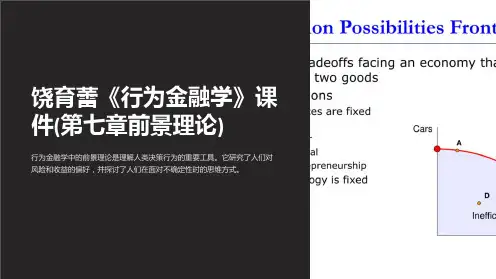
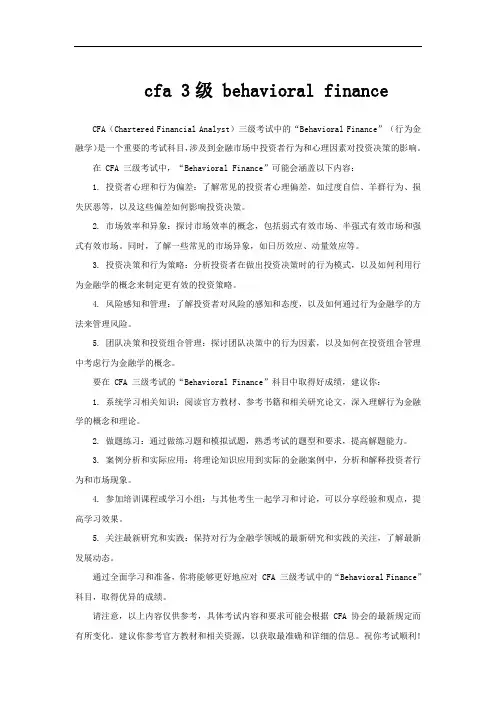
cfa 3级 behavioral financeCFA(Chartered Financial Analyst)三级考试中的“Behavioral Finance”(行为金融学)是一个重要的考试科目,涉及到金融市场中投资者行为和心理因素对投资决策的影响。
在 CFA 三级考试中,“Behavioral Finance”可能会涵盖以下内容:1. 投资者心理和行为偏差:了解常见的投资者心理偏差,如过度自信、羊群行为、损失厌恶等,以及这些偏差如何影响投资决策。
2. 市场效率和异象:探讨市场效率的概念,包括弱式有效市场、半强式有效市场和强式有效市场。
同时,了解一些常见的市场异象,如日历效应、动量效应等。
3. 投资决策和行为策略:分析投资者在做出投资决策时的行为模式,以及如何利用行为金融学的概念来制定更有效的投资策略。
4. 风险感知和管理:了解投资者对风险的感知和态度,以及如何通过行为金融学的方法来管理风险。
5. 团队决策和投资组合管理:探讨团队决策中的行为因素,以及如何在投资组合管理中考虑行为金融学的概念。
要在 CFA 三级考试的“Behavioral Finance”科目中取得好成绩,建议你:1. 系统学习相关知识:阅读官方教材、参考书籍和相关研究论文,深入理解行为金融学的概念和理论。
2. 做题练习:通过做练习题和模拟试题,熟悉考试的题型和要求,提高解题能力。
3. 案例分析和实际应用:将理论知识应用到实际的金融案例中,分析和解释投资者行为和市场现象。
4. 参加培训课程或学习小组:与其他考生一起学习和讨论,可以分享经验和观点,提高学习效果。
5. 关注最新研究和实践:保持对行为金融学领域的最新研究和实践的关注,了解最新发展动态。
通过全面学习和准备,你将能够更好地应对 CFA 三级考试中的“Behavioral Finance”科目,取得优异的成绩。
请注意,以上内容仅供参考,具体考试内容和要求可能会根据 CFA 协会的最新规定而有所变化。
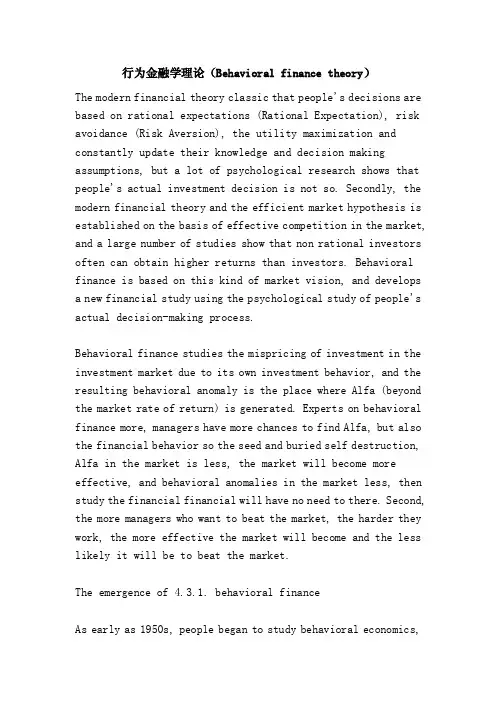
行为金融学理论(Behavioral finance theory)The modern financial theory classic that people's decisions are based on rational expectations (Rational Expectation), risk avoidance (Risk Aversion), the utility maximization and constantly update their knowledge and decision making assumptions, but a lot of psychological research shows that people's actual investment decision is not so. Secondly, the modern financial theory and the efficient market hypothesis is established on the basis of effective competition in the market, and a large number of studies show that non rational investors often can obtain higher returns than investors. Behavioral finance is based on this kind of market vision, and develops a new financial study using the psychological study of people's actual decision-making process.Behavioral finance studies the mispricing of investment in the investment market due to its own investment behavior, and the resulting behavioral anomaly is the place where Alfa (beyond the market rate of return) is generated. Experts on behavioral finance more, managers have more chances to find Alfa, but also the financial behavior so the seed and buried self destruction, Alfa in the market is less, the market will become more effective, and behavioral anomalies in the market less, then study the financial financial will have no need to there. Second, the more managers who want to beat the market, the harder they work, the more effective the market will become and the less likely it will be to beat the market.The emergence of 4.3.1. behavioral financeAs early as 1950s, people began to study behavioral economics,but earlier studies were rather scattered. It was not until 1970s that Kahneman (Daniel Kahneman) and Tversky (Amos Tversky) conducted extensive and systematic research on this field. Behavioral economics emphasizes that people's behavior is not only driven by interest, but also influenced by many psychological factors. The prospect theory combines psychological research and economic research effectively, reveals the decision-making mechanism under uncertainty, and opens up a completely new research field.4.3.2. is a leading representative of behavioral financeKahneman, the founder of Behavioral Finance (Daniel Kahneman) in 1934 was born in Israel in 1954, graduated from the Hebrew University, and in 1961 obtained a doctorate in psychology at the University of California, after the turn at the Hebrew University faculty. Another creator Tversky (Amos Tversky) was born on 1937 in Israel, has been at the University of Michigan studied philosophy and psychology at the Hebrew University, after graduation, here met his best partner Kahneman, which opened their lifelong friendship and excellence in academic research, and in 1979 jointly issued the basic theory of "behavioral finance prospect theory" (Prospect Theory). Later, he went to the University of California at Berkeley in the United States, and he went to Standford in the United states.Kahneman because of the prospect theory of behavioral finance contribution in 2002 received the Nobel Prize in economics, but it is a pity but Tversky in 6 years ago (1996 years) died, only 59 years old, can not wait for the arrival of honor.4.3.3. behavioral finance, major perspectivesBehavioral finance mainly puts forward two theories:A. BSV (Barberis, Shlefer, and, Vishny, 1998),B. DHS (Daniel, Hirsheifer, and, Subramanyam, 1998).First, the BSV theory holds that returns are stochastic, but the general investor erroneously believes that there are two paradigms for income change:Paradigm A: investors think that earnings change is mean reversion, and stock volatility is only a temporary phenomenon, and does not need to adjust its behavior according to changes in income. This behavior will cause investors to respond to the expected lack of earnings, and when the actual earnings do not match the expectations, they will be adjusted, so that changes in the stock price reaction to changes in earnings lags behind.Paradigm B: investors think that changes in earnings tend to be trend, and share prices have the same direction and continuous effects on earnings. Such investors tend to tend to expand the trend by mistake and overreact to changes in earnings.Second, DHS theory divides investors into two categories: one is the information one, the other is the non information. Without information, its investment behavior will not be affected by the judgment bias, and the information can be easily affected by the judgment bias.The DHS model divides the judgment bias of the information into two categories: one is overconfidence, and the other is biased self attribution (self-contribution). Overconfidence leads investors to exaggerate the accuracy of their stock valuation; biased self attribution leads investors to underestimate the impact of public information on stock value. That is to say, when the investor pursues this model, it will lead to the deviation between the personal information and the public information,This divergence leads to short-term continuity and long-term support for share prices.4.3.4. main behavioral finance modelUnder the framework of the two kinds of BSV and DHS, put forward the prospect theory of Behavioral Finance (Prospect Theory), behavioral portfolio theory (Behavioral Portfolio Theory) and the behavior asset pricing model (Behavioral BAPM Asset Pricing Model) on behavioral finance model.A. prospect theoryTheory (Prospect) combines psychological research and economic research effectively, reveals the decision-making mechanism under uncertainty, and opens up a whole new research field. In this sense, Kahneman's award may change the direction of future economics.In general, the prospect theory has the following three basicprinciple: (a) the majority of people in the face of the time are risk averse; (b) the majority of people in the face of loss when the risk preference; (c) are more sensitive to losses than get.Law of prospect theory: people are often cautious and unwilling to take risks when they are faced with them, while everyone is an adventurer in the face of losses. In the face of the time to avoid risks, and in the face of preference for the risk of loss, and the loss and the gain is relative to the reference point for the change, people use things in the evaluation point of view, can change people's attitude toward risk.The law of prospect theory two: People's sensitivity to loss and gain is different, and the pain of loss is far greater than that of happiness. In the 1992 study, Tversky and Kahneman found that people usually needed two times the loss of earnings to make up for the pain caused by the loss.B. behavioral portfolio theoryThe combination theory of BPT (Behavioral Portfolio Theory) behavior of assets, in 1985 by Shefrin and Statman put forward the theory that Pyramid investors have layered structure of the portfolio, each layer corresponds to the specific investment objectives and risk investors. Some of the money is invested at the bottom of the safest, and some funds are invested in more risky higher ups, with correlations between layers.Relatively speaking, the traditional portfolio theory to portfolio as a whole, and it is assumed that only the covariancebetween different securities account in building the portfolio, and are risk averse investors, and this behavior in real life is not entirely consistent.C. behavioral asset pricing modelBehavioral Model BAPM (Behavioral Asset Pricing asset pricing) investors are divided into information traders and noise traders. Information traders are rational investors who support the CAPM model of modern financial theory, avoid cognitive errors, and have variance preferences. Noise traders are apt to make conscious errors and have no strict variance preferences.When the information traders occupy the main body of the market, the market is efficient; when the noise traders occupy the market main body, the market is inefficient. In BAPM, the returns on securities are determined by the "Behavioral Beta", where the market portfolio is more representative. For example, noise traders tend to overestimate the price of growth stocks, and the proportion of growth stocks in the corresponding market is higher, because the behavioral portfolio is proportional to the market mix and the proportion of mature stocks should be raised.Statman further pointed out that the decision to supply and demand is people's utilitarian considerations (product costs, alternatives, prices, etc.) and value expression considerations (personal tastes, special preferences, etc.). CAPM includes only utilitarian considerations, while BAPM includes both. Due to the characteristics of BAPM value, andthe utilitarian characteristics, therefore, it is effective to accept a market from can't beat the market, on the other hand, from the meaning of rationalism of refuse market efficiency, the future development of finance has a profound revelation.In short, the behavioral finance through questioning on modern financial core hypothesis "theory of rational people", put forward the prospect theory, utility function of investors is concave function, and face the loss of utility function is a convex function. In financial transactions, investors psychological factors will make the actual decision-making process of optimal decision process is described from the classical finance theory, and system of rational deviation, and not because of the statistical average and eliminate.The investment strategies based on behavioral finance include average capital strategy, time diversification strategy, contrarian investment strategy and inertial investment strategy.4.3.5. behavioral finance explains the main behavioral anomalies in the marketA. overreactionPeople are too sensitive to asset prices, information conferences make people overreact, resulting in excessive or falling securities prices.B. disposition effectDue to the cognitive bias of investors,For the performance of the investment profit and loss of certainty ". The" loss aversion of the heart ", reflected in the behavior for selling profitable stocks to sell, easy to be a losing stock phenomenon, resulting in the relatively long time firmly.C. noise tradingShort - term investors and noise traders in the market have their own information. In his collection of information, by which investors more specific information, the more likely he is to profit, and such information may be associated with the basic value of information, also may be unrelated with the basic value of noise, which is called the information aggregation positive spillover effect. This effect may make the traders who obtain new information can not get the corresponding return, which is not conducive to the collection of information and the allocation of resources.D. herd effectInvestors are affected and imitated by other investors under the influence of uncertain information. That is, "all investors run in the same direction, and no one struggles with the overwhelming majority of people."."There are two main herding effects in the stock market:The first is the information based herd effectComplete information is a premise hypothesis of neo classical finance theory, but in fact, even in the modern society where information is highly disseminated, information is inadequate. In the case of insufficient information, investors do not make decisions entirely on the basis of their own information decisions, but on the basis of other people's investment behavior. The herding performance is "follow suit" or "the village" phenomenon.The second is the reputation based and reward based herd effectThis effect is most common in the fund manager, because employers do not understand the fund managers, fund managers do not understand their own investment capacity, in order to avoid investment mistakes and reputation risks and their remuneration, fund managers have motivation to mimic other fund managers' investment behavior. If many fund managers take the same action, the herd effect will emerge.。

【行为金融学】行为金融学阅读笔记在当今复杂多变的金融世界中,传统金融学理论常常难以完全解释市场中的种种现象和投资者的行为。
行为金融学的出现,为我们打开了一扇全新的理解金融市场的窗户。
传统金融学基于理性人假设,认为投资者能够做出完全理性的决策,市场总是有效的。
然而,现实中的金融市场却充满了各种看似非理性的行为和波动。
行为金融学则认为,投资者并非完全理性,他们的决策受到认知偏差、情绪和社会影响等多种因素的制约。
认知偏差是行为金融学中的一个重要概念。
例如,过度自信就是一种常见的认知偏差。
很多投资者往往高估自己的知识和能力,对自己的投资决策过于自信,从而导致过度交易和承担不必要的风险。
还有一种常见的偏差是锚定效应,投资者在做出决策时,常常会过分依赖初始的信息或参考点,而忽略了后续的新信息。
比如,在购买股票时,可能会因为股票之前的价格而影响对其当前价值的判断。
情绪在投资决策中也扮演着重要角色。
恐惧和贪婪是两种最主要的情绪。
当市场大幅下跌时,恐惧情绪可能会驱使投资者盲目抛售股票,而当市场繁荣时,贪婪又可能使投资者过度追涨。
这种情绪驱动的行为往往导致市场的过度波动和价格的偏离。
社会影响也是不可忽视的因素。
投资者常常会受到周围人的投资决策和观点的影响。
比如,在股市繁荣时,看到身边的人都在赚钱,自己也容易跟风投资,而忽略了潜在的风险。
行为金融学对于投资策略也有着重要的启示。
了解投资者的常见认知偏差和情绪影响,可以帮助我们更好地制定投资计划。
例如,采用逆向投资策略,在市场过度恐慌时买入,在过度狂热时卖出。
此外,行为金融学还对金融监管有着重要的意义。
监管部门可以通过对投资者行为的研究,制定更加合理和有效的监管政策,以维护金融市场的稳定和公平。
在实际的投资过程中,我们要时刻警惕自己可能存在的认知偏差和情绪影响。
学会独立思考,不盲目跟风,同时保持冷静和理性。
总之,行为金融学为我们提供了一个更贴近现实、更全面的视角来理解金融市场和投资者行为。
金融市场的行为金融学解析金融市场的行为金融学是一个研究金融市场参与者行为的学科,通过分析投资者的心理、决策和行为模式,揭示金融市场中的规律和现象。
本文将对行为金融学的概念、基本理论以及在金融市场中的应用进行解析。
首先,行为金融学是对传统金融学的一种补充和拓展,它不再假设投资者的行为是理性的,而是从心理学和行为经济学的角度出发,研究投资者的非理性行为。
行为金融学的核心理论之一是“有效市场假说”的否定,认为投资者的情绪、偏见和错误决策会导致市场出现非理性的价格波动。
其次,行为金融学提出了一系列关于投资者行为模式的理论。
其中,代表性启发式模型认为投资者会根据已有信息来形成对市场整体的判断,而忽视概率的变化;跟随群众的行为模式则认为投资者倾向于模仿他人的投资行为,导致市场形成羊群效应。
此外,损失厌恶理论、心理账户理论以及过度自信理论等也是行为金融学的重要理论基础。
行为金融学的应用范围广泛,其中最为典型的是对市场异常现象的解释与预测。
通过分析投资者的情绪和行为偏差,行为金融学可以解释为什么市场会出现过度反应和长期超涨、崩盘等现象。
此外,行为金融学对风险管理、资产定价、投资组合选择等方面也有着实际应用。
例如,通过研究投资者的情绪,可以预测市场的短期波动;通过评估投资者的风险厌恶程度,可以为投资者提供量身定制的投资组合建议。
此外,行为金融学的研究发现也为金融市场监管和投资者教育提供了借鉴。
了解投资者的心理和行为模式,可以帮助制定更合理的市场规则和监管措施,减少投资者的非理性决策和行为。
同时,通过投资者教育,可以提高投资者的理财能力和风险意识,减少错误决策和遭受损失的可能性。
总结而言,行为金融学是对传统金融学的一种补充和拓展,通过分析投资者的心理、决策和行为模式,揭示金融市场中的规律和现象。
它的应用范围广泛,不仅可以解释市场异常现象,还可以为风险管理、资产定价和投资组合选择等提供实际指导。
通过了解投资者的行为特征,行为金融学还可以为金融市场的监管和投资者教育提供有益参考,提高市场效率和投资者的理财能力。
Lecture 7 - Behavioral Finance: The Role of PsychologyOverview:Behavioral Finance is a relatively recent revolution in finance that applies insights from all of the social sciences to finance. New decision-making models incorporate psychology and sociology, among other disciplines, to explain economic and financial phenomenon, such as erratic stock price variations. Psychological patterns such as overconfidence and perceived kinks in the value function seem to impact financial decision-making, but are not included in classical theories such as the Expected Utility Theory. Kahneman and Tversky's Prospect Theory addresses such issues and sheds light on irrational deviations from traditional decision-making models.Reading assignment:Robert Shiller, Irrational Exuberance, chapters 3, 4, 8, and 9Jeremy Siegel, Stocks for the Long Run, chapter 19Fisher, Irving. "The Stock Market Panic in 1929." Journal of the American Statistical Association, Proceedings, 25 (169), pp. 93-6, 1930.Jenter, Dirk, and Fadi Kanaan. "CEO Turnover and Relative Performance Evaluation." NBER Working Paper No. 12068, February 2006.Financial Markets: Lecture 7 TranscriptFebruary 4, 2008Professor Robert Shiller: Today's lecture is about behavioral finance and this is a term that emerged into public consciousness around the mid-1990s; before that it was unknown. The term "efficient markets" is much older; I mentioned the idea goes back to the nineteenth century and the term goes back to the 1960s. But behavioral finance is a newer revolution in finance and it's something that I have been very involved with. I have been organizing workshops in behavioral finance ever since 1991, working with Professor Richard Thaler at University of Chicago. We've been doing that for eighteen years; amazing, that's a long time for you, right? When we started we were total outcasts, we thought; nobody appreciated us. I had tenure so I could do it but the problem is, you don't want to do things that are too out of fashion. Fortunately, we have a system that allows it to happen and I'm very happy to have that.What behavioral finance is a reaction against extreme--some extremes--that we see in efficient markets theory or also in mathematical finance. Mathematical finance is a beautiful structure and I admire what the people have done and I've worked in it myself, but it has its limits. Eventually--you know the way a paradigm develops--it goes through a certain phase. When mathematical finance was new, say in the 1960s, it was the exciting thing and nobody wanted to work on anything else; you wanted to be doing the exciting thing. As the '70s and '80s wore on, it got to be a little bit overdone; people run with it too far, they think that's all we want to do, and wedon't want to think about anything else. Then they start to get sometimes a little crazy. Than we had to reflect that, well, things aren't perfect. The world isn't perfect and we have real people in the world, so that led to the behavioral finance.Behavioral finance really means--what does it mean? It's not like behavioral psychology. It doesn't mean behavioral psychology applied to finance. It really means something much more broad than that. It means all of the other social sciences applied to finance. The economics department is just one of many departments in the university that teaches us something about how people behave, so if we want to understand how people behave we can't rely only on the economics department. I think that it's coming around to a unifying of our understanding. Since then--since the beginnings in the '90s, our behavioral finance workshops have grown and grown and, of course, so many people are involved in it now; it's now very well-established.Before I get into that, I want to give some additional reflections on the last lecture. I have this chart, which you saw last time--actually it's an Excel spreadsheet that--I also put it up already on the classes V2 website so you can play with it. I just want to reflect again--I know I'm repeating myself a little bit, but it's very important. What we have in this chart is the blue line, which is the Standard & Poor Composite Stock Price Index going back to 1871--from 1871 to 2008, right now--so that's like 130 years of data. That's the blue line. You can see the--do you know what that is there? That's 1929 and that is the Crash of 1929. Well, actually it extended to 1932 and you can see other historic movements. There's the bull market of the 1990s--a very big upswing--and then there's the crash from 2000 to 2003. I don't know if you remember these things, they were big news, not as big as the 1929 crash, but the upswing was just as big as the 1920s upswing, wasn't it? Here's the 1920s upswing and here's the 1990s upswing--huge upswing in stock prices. This is in logs, by the way, so that means that everything--the same vertical distance refers to the same percentage change in the price.Then I had, as I said last period, I have a random walk shown--that's the pink line. The random walk is generated by the random number generator. I fixed the random number generator, so I made it truly normal this time. It slows it down a little bit, but if you press F9 we get another random walk, but it's always the same stock price. This is a random walk with a trend that matches the uptrend of the stock price. I can press--it kind of looks similar, doesn't it? It kind of shows that in some basic sense the stock market and the random walk are the same. Here we have the crash of--here we have the market peak of 1929 except it turned out in this simulation to have occurred in 1910 or thereabout. Then we have the--that's The Depression of the '30s except it's not the '30s.I can just push a button and we get something else. I find this amusing. I don't know.Unfortunately, we live through only one of these in our lifetime. There's a TV show about parallel universes, right? What's the name of that show? I can't remember it. Don't you know this show? Where they go in some kind of time machine and they emerge in another parallel universe where history took another course. Well anyway, these are parallel universes that we see. In some of these universes, Jeremy Siegel would write his book, Stocks for the Long Run, and in some of them he would not because–well, this one he might not because in this case the stock market was just declining for the better part of a century.The thing I don't see in these charts and I think we haven't captured it perfectly with just the standard random walk is I don't see any crash as big as the 1929 crash. It's hard to get them. I keep pushing F9--this just seems to dominate, right? There's nothing as big here--press F9 again--you can keep pushing and pushing, maybe you'll get one but you have--you get the idea that there's something anomalous about that crash from the standpoint of this random walk theory. I'm not getting one, right? That's something that we'll talk about. I would--I'm not--I can push for a long time and I don't see--well there's a pretty big one. Isn't that just about as--not quite as sharp as the 1929 crash, but it's hard to get them.I think that one thing–there are a couple of things that we'll come back to. One is--I think I've already mentioned it--fat tales. Stock price movements have a tendency to show some extreme outliers that are not represented by the normal distribution. But also, there are variations in the variance. So, in this period here--in the '20s and '30s--the stock market was extremely variable on a day-to-day basis; it was way beyond anything we've observed since. So, that's why it seems to be more volatile in that period because the accumulation of bigger random shocks.Anyway, we can play this game for a while but now I want to go and talk about--remember that the random walk that we see in stock prices is not the behavior of a drunk, even though you can describe a random walk as drunken behavior. The idea in the theory is that these movements only appear random because they're news and news is always unpredictable. If the market is doing the best job--this is efficient markets--in predicting the future, that means then that any time the stock market moves it's because something surprising happened. Like there might be a new breakthrough in science or there could be war or something outside--this is the story--outside of the economic system that disrupts things.The next question then–now, I've added something--it's on this little tab here--I've added something, which is a plot of present values. This is something that I published in 1981. That's a long time ago, isn't it? It was my first big success. Not everyone liked this article, but what I had--I got into a lot of trouble for it. I learned some people react with hostility when you offend their cherished beliefs, so I was on the outs for a while with this article. I said, it's kind of interesting to think that all these apparently random movements are really resulting in news about something that is fundamental--that's the efficient markets. Every time the stock market moves it's because there was some news about what? Well, it's about present value.The efficient markets theory, in its simplest incarnation, says that the price is the expected present value of future dividends. What I did, in a paper that I published in 1981, is I said, well let's just plot the present value of dividends through time. That's how I constructed this long time series back to 1871; nobody else was looking at it. Typically, researchers want the best data, the high quality data, and so they would look at recent data, which was the best data, and they would think going back to 1871 is crazy because that's so long ago. We have daily or minute-by-minute data by now, but we can't get it for that remote period. On the one hand, as I argued, the stock market is pricing things that occur over long periods of time. The present value formula is pricing dividends into the future, decades into the future--well, actually to the infinite future, but most of the weightis on the next few decades. So, we can't evaluate the theory by just looking at ten years of data we've got to get a lot of data.What I did then in that paper was I computed the actual present value of subsequent dividends for each year--that's on this tab--and compared it with the stock price; so that's what I did. This is an update of a plot that I showed in my 1981 American Economic Review paper. The blue line--because when I published it I was right here. It's amazing how time goes by; it was 1979, I was right here. We had just come off from the big stock market drop of the--it was the '73-'75 drop and it was a couple of years later, so we were kind of bumbling around down here. We didn't have any idea whether this was coming at the time.What I did was I just, for each year, computed the present value of the dividend. I have a dividend series for every year. In fact, it's right over here. I have to--this is the data, so I have the--this is the S&P Price Index monthly, back to 1871, and here are the dividends they paid per share every year since 1871. I just, for each year, I took all subsequent dividends and I priced them out at the present value formula and I used the constant discount rate of 6% a year. So, you see how we get what the present value was. Of course, there's a problem because we don't know dividends after 2007 because we don't have data on dividends past then. But, I just made some assumptions, so the value at the end is maybe a little bit arbitrary. It could be dragged up or down if I made a different assumption about dividends at the end. More or less, this is going to be what actually the present value of dividends was over this whole period.Here's the dilemma--this is what I said in my 1981 article--this is the thing that is supposed to be forecasted. That's the present value and the blue line is the forecast of that thing. Then you ask, does this look like a good forecast? Were people doing a good job of forecasting the red line with the blue line? Now, that may be a loaded question; but, I think that you get the impression that there's something possibly wrong here with efficient markets because the red line is just a smooth growth path like nothing happens to it and yet the stock market is going up and down all over the place. It's a little bit like if you had a weather forecaster and this morning he says, I predict today that the low today will be -100º and then two days later he says, I predict that the low today will be +150º. You would eventually start concluding that this weather forecaster can't be trusted because we never get to those temperatures. That's sort of what the stock market is doing; it's fluctuating much more than the thing that's forecasted. You've got to be careful; I ended up with so many critics.There are lots of issues here that--some people said, well people don't know where the red line was last period. And other people said, well you just are showing one reality for the realization--you're showing--they kind of get back to this parallel universe story. There must be another universe where there's another Earth and where everything looks the same except that the red line did something very different; that could be. So, people are saying, you never know, there could have been a communist revolution in America in the 1930s and they could have nationalized the whole stock market and then the red line would be down at zero--they would have taken the whole thing. Or there could have been some good news, some great breakthrough that we haven't discovered yet but in another reality they could have. So, all this noise in the stock market couldhave somehow been new information about things that didn't happen. I think we're getting kind of philosophical when we go to that. The point is that we've never seen any movement in the present value of dividends that would justify the movement. If we knew the future with certainty, according to this model, then the stock market would behave like the red line, not like the blue line.Well, anyway. For example, let's look at the Great Depression of the 1930s, at the very least I think this chart will reveal some misconceptions that some people have. The Great Depression of the 1930s was awful, right? I mean you hear these stories; I assume you hear these stories. We had 25% unemployment at the peak--it sounds really bad. We had people selling apples on the street; you must know these images, right? It sounds awful, but look what happened to p* in the Great Depression. I can hardly see anything. Well, what actually happened was businesses continued paying their dividends right through the whole Depression and some of them cut their dividends, but it was only for a few years. The present value of--the value of stock depends on what it pays out over decades not just next year. The stock market--if people knew the--even if they knew the depression was coming, they shouldn't have marked down the stock market so much, according to this simple efficient markets story--according to the present value story.At the very least, I think that this diagram helps you to see what is wrong or what simple theories are wrong. So, it must be that if the stock market is reacting to new information over all this century of history, it must have been new information about things that just didn't happen. It could be that an asteroid almost struck the Earth and then it just missed and so the stock market crashed. Then when it missed it came back up again, so we don't see any interruption in dividends. But it has to be something like that. The problem is, I can't think of anything like that. I don't think that any asteroid came close to the Earth--not close enough to be worried about--and I can't think the communist revolution had much chance of taking place in the United States--but you can imagine--so we don't know.Behavioral finance kind of tends to reach the opposite conclusion: that this volatility in the stock market is the sign of something else; it's some social force, some speculative bubbles, some activity that is not related to anything fundamental. The reason I got so much hostility when I wrote these papers is I was striking a nerve, I guess, because many people have developed these beautiful mathematical theories that said that the stock market was the optimal predictor of everything and I was saying the emperor has no clothes; so there were others like that. What is happening? What I'm coming around to think--maybe it's my cynical view, I've always been a cynic. I don't know if you are cynics or not, but I think people convinced themselves of things. They--people think they understand things better than they do. You spend your whole life looking at this one picture of the stock market and you think you have an explanation for all of it--all rational good--but it's just over-confidence that's doing that; it's an illusion.I want to talk about over-confidence and I thought I'd try–there's also no eraser. Can you find another eraser? There's probably one in this closet. I wanted to try an experiment of asking you a series of a few short questions. It's a game we'll play, which I'll need your cooperation with. So, these are questions about over-confidence. Actually, I just want you to try to give me 90% confidence intervals for the answers to these questions. Do you know what a 90% confidenceinterval is? It's, for example, if I were to ask you what--how many people are there in New Haven?I want you to not just give me a number, I want you to give me a range such that you're 90% sure that you're right. I could say, well, it's between 90,000 and 100,000 people and I'm 90% sure I'm right. If you give me a true 90% confidence interval, then you should be right 90% of the time, right? What I'm going to do is give you a few questions and ask you for a 90--ask you to write down--you have a piece of paper there--a 90% confidence interval. I have five questions; this is just an experiment.The first one is about the Statue of Liberty. What does it weigh in pounds--in tons? Good, thank you. So, weight. Incidentally, just to remind you, a U.S. ton is 2,000 pounds--not a British pound, which is 2,240 pounds--and a ton is 907 kilograms. Can you write down on your paper your 90% confidence interval? For example, I won't use realistic numbers. If you thought it was--you might write down, it's between one pound and three pounds and that you're 90% sure it falls in that interval. I didn't say--its tons, tons. I'm asking--it's more than a pound--I'll give you a hint, it's in tons. Let me also say, we're not weighing the base. The Statue of Liberty stands on a tall edifice; we're not counting that but we're counting also the steel reinforcing that they put in a few years ago. Remember, the Statue of Liberty was getting weak and they were worried that something might topple down, so they reinforced it and we're counting that. So, it's a copper structure with steel reinforcement.Can you write down on your notes a range within which you're 90% sure that the statue weighs, in tons? If you could do that--I'm going to come back--what I'm going to do is come back and see how often you are right so we'll go back through these. Have you all written down a weight for the Statute of Liberty? Population of the country, Turkey. Since I don't have the current population, I want it in the year 2000. I didn't get the latest estimate; so, how many people were there in Turkey in 2000? And again, put down a range, a low and a high, that's 90% sure. Third, the Sahara Desert. How many square miles in the Sahara Desert? Remember that a square mile is 2.6 square kilometers; just in case you think in terms of kilometers, you can devise your answer in kilometers and then multiply by 2.6. Again, write down a range. Enrollment at Yale.By the way, I should have asked, you have to be honest with it. You could game me by writing really wide intervals for nine of ten questions and then an extremely narrow interval for the tenth. I'm expecting some sincere cooperation here--then you would guarantee that you were right exactly 90% of the time, right? I mean, you could say the Statute of Liberty weighs between zero and a hundred quintillion tons and you know you're right. Then you could deliberately say the population of Turkey is between one and two people and then you know you're wrong. You could do--you're not supposed to do that. I want the enrollment in Yale; I don't have the latest number--2005. That's the total number of students at Yale University in 2005, including Yale College and all the graduate schools. The fifth question is about the Pulitzer Prize. Do you know this prize? It's a prize that journalists win for writing great articles or books. I want to know, what is--how much do you get in cash if you win the Pulitzer Prize? I have it for last year, 2007; it might be different in 2008, so I'm asking for the 2007, in dollars. I hope you were honest in putting confidence intervals. Have you gotten them?Now, what I'm going to do, if you've answered all five questions, I'm going to tell you the answers--the correct answer--and then ask for a show of hands of how many--please be honest and don't be embarrassed. Raise your hand if you were right, meaning that if my answer falls within your 90% confidence interval, okay? Let's go to the Statue of Liberty. The Statue of Liberty weighs 252 tons. So, can I have a show of hands--how many people here have 252 in the interval? You're doing fairly well; what fraction–keep your hands up--looks like it's about, what would you say, 20-25%? Thank you for being honest and not gaming me. It should have been 90% who were right.What is the 2000 population of Turkey? I'll give you the exact number that I got from their statistic: 65,666,677. That's a little over sixty-five million. How many people have that in their interval? That's better; that's like 40%--40% or 50%. You're doing better but it's still not 90%. How many square miles in the Sahara Desert? 3.5 million. Can I get a show of hands--how many were right on that? Well, this one really got you, that was like 5%. Was anyone right on all of them so far? Nobody. Enrollment in Yale, Fall 2005? 11,483 students. How many were right? Okay, that's about 40%--right close to 40%, I'd say. Finally, how much do you win if--how much do you receive if you win the Pulitzer Prize? $10,000. Can I have a show of hands? That was really low, that's like 5%. I knew that was a trick because you've heard about the Nobel Prize. Those are both prestigious, right? Nobel Prize gives you something on the order of $1,000,000 and the Pulitzer Prize gives you something like--it only gives you $10,000. So how can that be? I sort of picked something that I thought you might be wrong on.That reveals something about human behavior. It's a choice in life. You go into different walks of life. This is something that's fundamental to economics: there are just different expectations about how much money you're going to make. If you go into the news media--and I think that's a wonderful career--you're not going to make much money probably. The whole thing is just scaled down and I think there's something revealing about this that we just have social norms for how much someone is to be paid. If you were to give Stephen Schwartzman a $10,000 prize, it would be more like an insult than anything. But if you are working for The New Haven Register and you get this prize, it's a life-changing event, not because of the $10,000 maybe--even they get more money than that.Anyway, the point was that people tend to be overconfident. Incidentally, it's not just males; females are well-known to be overconfident too. There is a thing about macho males--"know it all"--but experiments prove that women have the same problem. That's why I think that when we look at charts of the stock market, we see things that we think we understand, especially young people. They get deluded into thinking they understand more than they really do. I wanted to talk about some authors that I admire who have written about this. These are books that I don't have on the reading list, but they're fun to read. There's a professor at The Harvard Business School, Rakesh Khurana; he has a book on the search for charismatic CEOs. It's not just overconfidence in yourself; we tend also to put overconfidence in leaders. We have a sense that some people are just natural geniuses and know everything, so we think that they can transform our lives or our companies. So, boards of directors are constantly looking for a CEO who is a genius and they keep getting fooled and disappointed. They bring someone in and this person often messes thingsup more than helps because this person realizes that he or she has to live up to this genius role, so they better do something. So, they do something in a flailing way, not understanding what they're doing, and they mess up the whole company.Really, a lot of what happens--good things that happen in human society--are the result of lots of people doing their own special things and all working together. There's no great genius but there's this idea in our mind that we are going to be such a thing. Related to that--and I wanted to mention, it's on the reading list--an article by one of my students in this class, who's now at MIT. He took this class about ten years ago, Fadi Kanaan and co-authored with another MIT professor, Dirk Jenter, again looking at overconfidence in our judgments. Again, they looked at CEOs, chief executive officers of companies, and they found that companies in industries that fail tend to fire their CEOs. This is unjust; this is an overreaction. You bring in this CEO who's supposed to be brilliant and then the business fails, so you fire the guy right after that.We're kind of manic-depressive about these guys. When the business fails, we think we were such a mistake. This guy had such promise and he just didn't live up so we get rid of him; but in fact, they found that the CEO gets fired even if the whole industry went down. So, you can't blame the CEO for the fact--if you're one company in an industry and the whole industry goes down--or the remaining industry even not including that firm--it's not the CEO's fault. We tend to be kind of wild and extreme in our judgments. You've seen that a lot--a lot of CEOs lost their jobs recently in the subprime crisis. Was it their fault? Probably not, but they get fired anyway. We go through this manic-depressive--we try to hire charismatic CEOs, then we get disappointed and we keep going through musical chairs one after another.Nassim Taleb, who lives here in Connecticut and I know him well, has a book called Fooled by Randomness, which was a best-seller and it's very fun to read. It's a story--he's a Wall Street--he had an investment management firm and he observed a lot of people. It's a book about how people over interpret--they tend to blame themselves for failures and congratulate themselves for successes too much and they don't realize that it's just random. Some guy who's in a business--business is succeeding--why is it succeeding? Because the guy came in, dumb luck at the right time and everything is supporting that, concludes that he's a genius. Then Taleb observes them later, after things don't go so well, and suddenly they're depressed. –I talked to stockbrokers before and after the '87 stock market crash and one of them told me--or maybe more than one of them told me--I can tell that the crash occurred from the tone of voice of the people when they call up the phone. When the market was soaring just before the '87 peak, he said they would call up and they were brash and rude to me and they would say, let's trade this, get this done--kind of just disparaging subtlety, the stockbroker. Then after the crash, when these people were sort of--many of them--wiped out, they'd answer the phone in a sheepish way. You could just tell in the tone of their voice that they were crushed. So, that's what happens.I also have down on this part of the reading list Irving Fisher, who was a professor at Yale, who was a very prominent economist in the first half of the century. He's another Yale graduate, Yale Class of 1895, I think. I'm sure he lectured on this stage because this building was--his office was in this building, I believe. He died around the mid-1940s but he's famous for overconfidence. In。